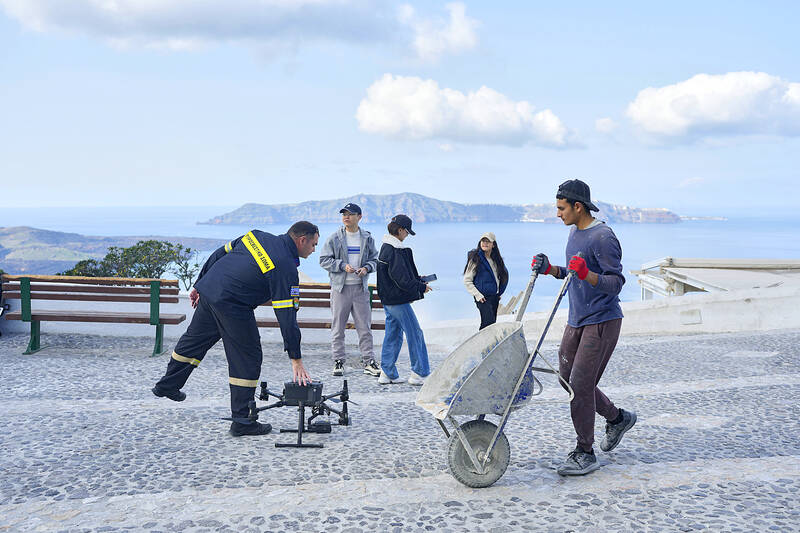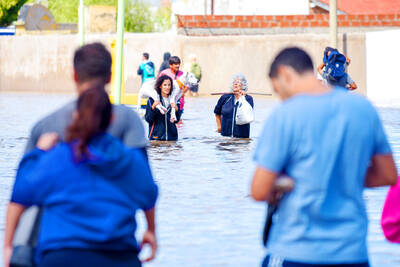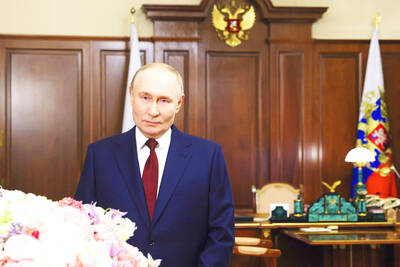Schools were closed and emergency crews deployed on the volcanic Greek island of Santorini yesterday after a spike in seismic activity raised concerns about a potentially powerful earthquake.
Precautions were also ordered on several nearby Aegean Sea islands — all popular summer vacation destinations — after more than 200 undersea earthquakes were recorded in the area over the past three days.
“These measures are precautionary, and authorities will remain vigilant,” Greek Minister of Climate Crisis and Civil Protection Vasilis Kikilias said late on Sunday following an emergency government meeting in Athens. “We urge citizens to strictly adhere to safety recommendations to minimize risk.”

Photo: AP
While Greek experts say the quakes, measuring up to magnitude 4.8, are not linked to Santorini’s volcano, they said the pattern of seismic activity is a cause for concern.
The frequency of the quakes, which continued throughout Sunday night and into yesterday, has worried residents.
“I have never felt anything like this and with such frequency — an earthquake every 10 or 20 minutes. Everyone is anxious even if some of us hide it not to cause panic, but everyone is worried,” said resident Michalis Gerontakis, who is also the director of the Santorini Philharmonic Orchestra.
“We came out yesterday and performed. Despite the earthquakes, the philharmonic performed for a religious occasion,” Gerontakis said. “When you are playing, you cannot feel the quakes, but there were earthquakes when we were at the church. No one can knows what will happen. People can say whatever they like, but that has no value. You cannot contend with nature.”
Government officials met with scientists throughout the weekend and yesterday to assess the situation, while schools were also ordered shut on the nearby islands of Amorgos, Anafi and Ios.
On Santorini, residents and visitors were advised to avoid large indoor gatherings and areas where rock slides could occur, while hotels were instructed to drain swimming pools to reduce potential building damage from an earthquake.
Fire service rescuers who arrived on the island on Sunday set up yellow tents as a staging area inside a basketball court next to the island’s main hospital.
“We arrived last night, a 26-member team of rescuers and one rescue dog,” fire brigadier Ioannis Billias said.
Quakes continued rattling the island through the night and yesterday morning, many above magnitude 4.0, and Billias said many residents, including entire families, spent the night in their cars.
Crescent-shaped Santorini is a premier tourism destination, with daily arrivals via commercial flights, ferries and cruise ships. The island draws more than 3 million visitors annually to its whitewashed villages, built along dramatic cliffs formed by a massive volcanic eruption more than 3,500 years ago.
Greek seismologist Gerasimos Papadopoulos cautioned that the current earthquake sequence — displayed on live seismic maps as a growing cluster of dots between the islands of Santorini, Ios, Amorgos and Anafi — could indicate a larger impending event.
“All scenarios remain open,” Papadopoulos wrote in an online post. “The number of tremors has increased, magnitudes have risen, and epicenters have shifted northeast. While these are tectonic quakes, not volcanic, the risk level has escalated.”
In Santorini’s main town of Fira, local authorities designated gathering points for residents in preparation for a potential evacuation, though Mayor Nikos Zorzos emphasized the preventive nature of the measures.
“We are obliged to make preparations, but being prepared for something does not mean it will happen,” he said during a weekend briefing. “Sometimes, the way the situation is reported, those reports may contain exaggerations ... so people should stay calm.”

ANGER: A video shared online showed residents in a neighborhood confronting the national security minister, attempting to drag her toward floodwaters Argentina’s port city of Bahia Blanca has been “destroyed” after being pummeled by a year’s worth of rain in a matter of hours, killing 13 and driving hundreds from their homes, authorities said on Saturday. Two young girls — reportedly aged four and one — were missing after possibly being swept away by floodwaters in the wake of Friday’s storm. The deluge left hospital rooms underwater, turned neighborhoods into islands and cut electricity to swaths of the city. Argentine Minister of National Security Patricia Bullrich said Bahia Blanca was “destroyed.” The death toll rose to 13 on Saturday, up from 10 on Friday, authorities

Local officials from Russia’s ruling party have caused controversy by presenting mothers of soldiers killed in Ukraine with gifts of meat grinders, an appliance widely used to describe Russia’s brutal tactics on the front line. The United Russia party in the northern Murmansk region posted photographs on social media showing officials smiling as they visited bereaved mothers with gifts of flowers and boxed meat grinders for International Women’s Day on Saturday, which is widely celebrated in Russia. The post included a message thanking the “dear moms” for their “strength of spirit and the love you put into bringing up your sons.” It

DEBT BREAK: Friedrich Merz has vowed to do ‘whatever it takes’ to free up more money for defense and infrastructure at a time of growing geopolitical uncertainty Germany’s likely next leader Friedrich Merz was set yesterday to defend his unprecedented plans to massively ramp up defense and infrastructure spending in the Bundestag as lawmakers begin debating the proposals. Merz unveiled the plans last week, vowing his center-right Christian Democratic Union (CDU)/Christian Social Union (CSU) bloc and the center-left Social Democratic Party (SPD) — in talks to form a coalition after last month’s elections — would quickly push them through before the end of the current legislature. Fraying Europe-US ties under US President Donald Trump have fueled calls for Germany, long dependent on the US security umbrella, to quickly

In front of a secluded temple in southwestern China, Duan Ruru skillfully executes a series of chops and strikes, practicing kung fu techniques she has spent a decade mastering. Chinese martial arts have long been considered a male-dominated sphere, but a cohort of Generation Z women like Duan is challenging that assumption and generating publicity for their particular school of kung fu. “Since I was little, I’ve had a love for martial arts... I thought that girls learning martial arts was super swaggy,” Duan, 23, said. The ancient Emei school where she trains in the mountains of China’s Sichuan Province